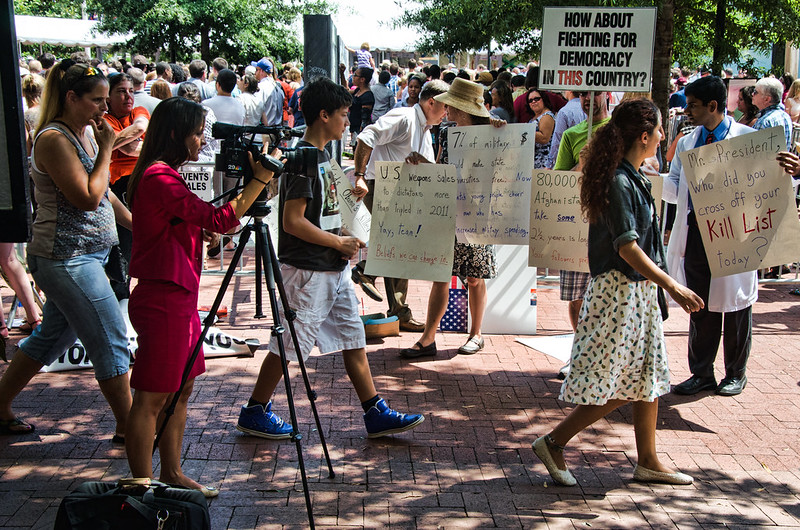All news outlets should rethink field safety when sending reporters alone on assignment
A young TV reporter in West Virginia recently was struck by a vehicle while reporting on a water main break. The local NBC-affiliate where she worked never broke from the story, even as it was clear she had been run over.
WSAZ-TV stayed live as Tori Yorgey yelped and exclaimed, “I just got hit by a car.” Later, still hidden from view, her camera recording the dark, wet pavement, she declared, “That’s live TV for you.”
Yorgey was hailed for keeping her composure and bouncing back up to finish the report. Fortunately, she was not seriously injured.
But in the hours and days that followed, TV reporters, particularly women, lambasted an industry that heavily relies on multimedia journalists, reporters who serve as one-person crews for breaking news stories. Multimedia journalists are responsible for shooting, setting up stand-ups (and then getting in front of the camera to operate it remotely) to deliver the news without a photographer.

One TV reporter described on social media how her bosses routinely sent her to cover crime stories, with suspects still on the loose, and before the police were on the scene. Another was assaulted at an immigration rally. Her news directors brushed it off as “the risk of the job.”
GJR published an op-ed by Nikki Davidson, a former multimedia journalist, who called on TV stations to stop sending multimedia journalists out alone on assignments. And the National Press Photographers Association pressed for a “renewed focus on field safety.”
It would be easy for those of us in print journalism to write this off as a problem for TV news reporters. After all, TV crews, like photojournalists, are particularly vulnerable because of their gear. Writers can hide easier. We don’t show up with a camera, which can be provocative.
But the fact is that media organizations, traditional print publications included, have long put female reporters in dicey situations without concern for their safety. For our part, many female journalists have gone along with it, myself included. Newsrooms like to perpetuate the image of a hardened, risk-taking reporter who doesn’t come back without a story. In a competitive industry, many reporters take risks to get ahead, something I observed as a war reporter overseas.
False bravado is outdated. We don’t have to make ourselves tougher than we are to gather accolades. We tell young reporters our stories of banging on doors in the middle of the night, of following people like it’s a rite of passage. And while I certainly stress the importance of shoe-leather reporting now as a journalism professor, I also remind my students of what Don Graham, my then-publisher at The Washington Post, told me before I went to Iraq for the first time: “No story is worth your life.”
Not all publishers, editors or TV news editors send the same message, perhaps because the leadership at most media organizations are still dominated by men.
Women are in 40 percent of the leadership roles in America’s print and online newsrooms, according to the annual News Leaders Association survey.
While women of color have risen to top leadership roles in broadcast TV, with Kimberly Godwin now the president of ABC News and Rashida Jones the president of MSNBC, only a third of local news directors are women. The majority of women in TV work in local TV markets.
Women journalists are more likely than their male counterparts to be targets of violence and online harassment. Solo reporting puts them at particular risk, and TV is not alone in sending one-person crews to cover the story, particularly as newsrooms staff shrink and the cost of covering stories increases.
The trend in solo reporting has drawn the attention of the Committee to Protect Journalists, which released tips in 2019 for journalists who have to cover potentially dangerous assignments on their own. Among them, CPJ encourages journalists not to drive alone to a remote area and to talk to managers about concerns.
That is easier said than done. Women TV reporters tell stories of being rebuffed when bringing up their concerns. Or producers and directors not bothering to check in after they’ve been shot at, run off the road or assaulted. That is not acceptable, and as an industry, both men and women need to stand up against such callous disregard for the frontline multimedia journalists who are asked to go get the story.
Smart reporters who use calculated risks to get a story and who exercise smart situational awareness should be awarded.
We should applaud when a reporter like Yorgey brushes herself off after an accident and keeps going. But we shouldn’t encourage the risk in the first place.
A version of this story first appeared in Publisher’s Auxiliary, the only national publication serving America’s community newspapers. It is published by the National Newspaper Association. GJR is partnering with Pub Aux to re-print Jackie Spinner’s monthly “Local Matters” column on our website. Spinner is the editor of Gateway Journalism Review. Follow her on Twitter @jackiespinner.


